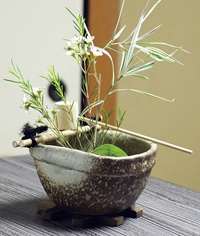Earthenware - Japanese Traditional Culture | Glaze
Glaze
Abura-age-de

Glaze that looks like deep-fried toufu; found on Ki-Seto ware.
Ame-yu

Ame means amber and yu means glaze. Ame-yu can be translated as amber (caramel) glaze - it contains iron oxide or manganese oxide with feldspar. Often seen on chawan (tea bowls) and mizusashi (water jars).
Goma

"Sesame" colored natural ash glaze from pine ash that fuses and melts on a pot. Some goma are called nagare-goma (flowing goma) or tobi-goma (spotted flying goma). Mainly found on Bizen.
Go-sai

In Kutani pottery, the five colors (go-sai) reign supreme: red, blue, yellow, purple and green.
Gosu

Cobalt blue glaze.
Kairagi

Crawling of the glaze - mainly seen on Karatsu and Hagi wares around the kodai (foot).
Kinrande

Gold enameled porcelain.
Tetsu-yu

Iron glaze.
Yohen

Natural ash glaze. Literally means "changed by the fire/flame." Yohen refers to changes in the kiln that cause the glaze to run during firing. Sometimes this is called a "hares-fur" effect. Yohen also refers to the build-up of ash on the kiln floor and the natural glazing brought about by this ash, resulting in deep blues, browns, and reds -- often seen on yakishime ware, like Bizen.
Yuri-kinsai

Underglaze gold decoration porcelain. Designated in the 1950s as a new glazing technique.
The main feature is a highly transparent overglaze on gilded porcelain.
Copyright© Earthenware All Rights Reserved.
